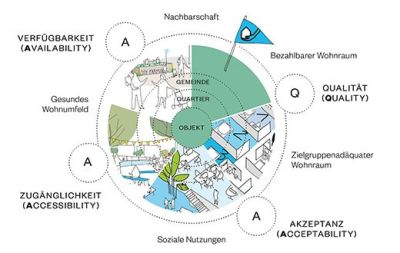What actually makes a property “social”? Until now, the real estate industry has lacked a uniform classification system to truly quantify the second dimension of ESG. Quantum aims to close this gap and has developed its own assessment system for socially sustainable real estate.
Five criteria are intended to make the social sustainability of residential properties measurable:
1. Affordable housing
Demand for affordable housing far exceeds supply, especially in major cities. At the same time, prices in the lower market segment are rising sharply. It is therefore crucial that the largest possible share of subsidized or (voluntarily) rent-dampened apartments is available and accessible to all. The latter can be designed in a socially sustainable way by using defined, transparent criteria and less discrimination-prone forms of housing allocation.
2. Target group-appropriate housing
The existing housing stock no longer meets the requirements of increasingly diverse household structures. There is a particular shortage of small apartments for single households, family-friendly housing, and low-barrier or barrier-free apartments for older people. A residential investment can contribute to a better match of the housing stock by offering an appropriate mix of apartment sizes and layouts.
3. Social neighborhood
Socially sustainable action in housing markets should aim to create and maintain stable neighborhoods in residential quarters. A variety of apartment sizes and different rent levels can foster social mix. The residential environment and its infrastructure also influence social life in the neighborhood. Therefore, it is important to create places for encounter and interaction (including playgrounds), involve residents comprehensively, or implement neighborhood management.
4. Social uses
Properties and districts should promote the social participation of different population groups. This can be achieved primarily through social facilities such as educational and cultural institutions or care services. In addition, providing rent-reduced spaces can further support the offerings of social institutions.
5. Healthy living environment
Both the natural and built environment influence public health. Urban areas with dense settlement structures are often associated with health-harming burdens. Conversely, the built form of a city, district, or neighborhood — through sufficient green spaces or movement-friendly areas — can promote residents’ health and thus deliver a social benefit.
“Ecological, energy-efficient, and green — these terms are now firmly anchored in the real estate industry. However, the social aspects of real estate are still often treated as secondary. One reason: environmental aspects are mostly based on scientific data and can be well expressed in numbers, for example CO2 reduction. Social aspects, on the other hand, are based on norms and principles. That makes them so complex,” says Dr. André Scharmanski, Head of Quantum Research.
Quantum’s assessment system is based on the EU’s so-called AAAQ framework for the future implementation of a social taxonomy. It provides that products and services are evaluated according to the principles of Availability, Accessibility, Acceptability, and Quality.
You can find the entire assessment system in detail, graphics, statistics, and background information on the social taxonomy in the new issue of the Quantum publication “Focus.”
We would be happy to provide additional graphics for your coverage. We also gladly offer interview opportunities to explain the assessment system.


